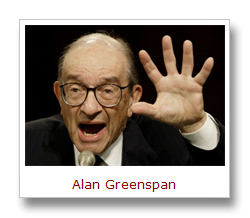Is it just me, or do profound statements by economic pundits seem a lot like predictions made by the Delphic Oracle or Nostradamus?
Their statements are murky enough to be interpreted in different ways and — eventually — something will happen that at least appears to confirm some part of what they said.
For example, on December 5, 1996, the Chairman of the U.S. Federal Reserve Board, Alan Greenspan, uttered the profound phrase “irrational exuberance.”
He was discussing potential issues facing our economy, or our monetary policy, or the stock market, or all three.
Or something like that.
Here, from the speech he gave that day at the American Enterprise Institute in Washington, D.C., is the first part of the paragraph in which Greenspan’s famous two-word quote appears:
“Clearly, sustained low inflation implies less uncertainty about the future, and lower risk premiums imply higher prices of stocks and other earning assets. We can see that in the inverse relationship exhibited by price/earnings ratios and the rate of inflation in the past. But how do we know when irrational exuberance has unduly escalated asset values, which then become subject to unexpected and prolonged contractions as they have in Japan over the past decade?”
OK, I believe Greenspan’s oracular mumbo-jumbo must mean something to economic experts and bankers. (You now, the guys that helped create the economic mess were in today — and made money doing it twice: first when they created the mess and then when taxpayers bailed them out.)
But if Greenspan is so damn smart and prescient, why didn’t he do something to prevent the Dot-com bust, and the mortgage and banking crisis, and the other economic messes that happened or began to develop while he was Chairman of the Fed, from 1987 to 2006?
And, speaking of irrational exuberance, the year after Greenspan coined that term, at the age of 71, he married TV journalist Andrea Mitchell — who is 20 years younger than him.
I predict that future scrutiny of the inverse relationship exhibited by the Greenspan/Mitchell age ratio could someday give new asset values to Greenspan’s famed term.
.



